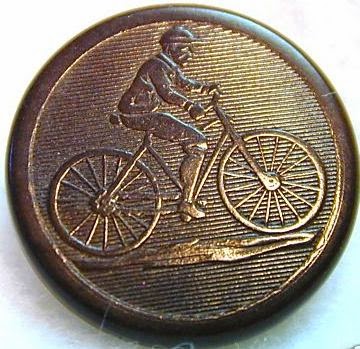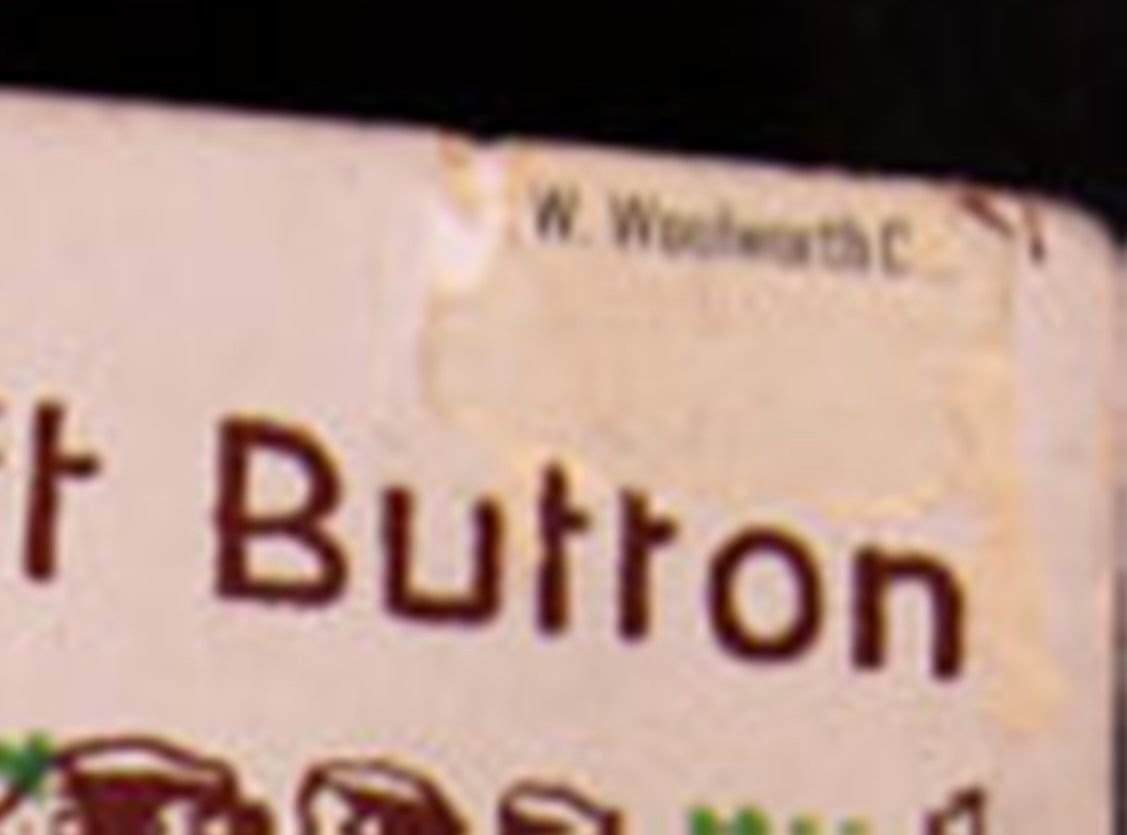I never was a big one for Victorian metal picture buttons. Plenty have come my way over the years, and well... they're usually just okay. That said, I like to add buttons to my collection that are odd and unusual and have a little weirdness. Kind of like me! LOL Usually, a button that has an interesting material tends to grab my attention (and my wallet) first.
I trip through the interwebz and auctions searching for fun things for my collection on lazy mornings when Cinderella (the name I gave my Neato robotics vacuum) is buzzing around on the floor doing my bidding and my work for me and Luna the Wonder Chihuahua is taking a nap in my lap.
A few weeks ago, while feeling particularly lazy and looking for some button fun, I came across this Large size, raspberry tinted beauty, almost hidden in the group of other antique buttons it was piled in with.
 |
| Large, 1-1/2" |
WOW what is that? A bicycle? Nope, it has THREE wheels. A TRICYCLE? Hmmmm.
 |
| Some buttons just make you go HMMMMMM. |
 |
| Back View. No verdigris on this old gal, just an odd reflection on bottom edge of the rim in the photo. |
I see an article on-line written by Mr. Leon Dixon on how the early 3 wheel bicycle contributed to the development of the auto industry and I learn about the first Benz Patent Motorwagen, which also had 3 wheels. More hmmmm. The Benz vehicle sure looks like this vehicle!
So, I've paged through my Big Book of Buttons (a must have reference book) and probably 10 or 12 of my other old button books. So far, I can't find any reference or photo to this button. The only other button like it (same woman design) is a black glass button, shown in The Complete Button Book, Lillian Smith Albert and Kathryn Kent - p. 158, #14. Nothing about the button is really mentioned but the material and the tricycle.
I do know that early collectors frequently found button designs that were based on historical events or artwork and wondered if this was one of those buttons. I returned to look at the information in the Dixon article on the Benz, but also decide to find out if it's possible that this is a a tricycle. I start by contacting the author of the article who hopefully will A) respond and B) take a look at the button because C) he knows about both of them.
Leon Dixon, (a legend among bicycle collectors, www.nbhaa.com) is a well known and respected authority on bicycle collecting. He has been collecting since the 1953 and owns some of the rarest of bicycles and related ephemera ever made. He was kind enough to email back almost immediately even though he was travelling. You can see from the photo of the Benz (replica) why at first I connected it to the design.
He knew that. :)
He said there was no possibility that this button it was a depiction of Bertha Benz taking the first long distance motorized vehicle trip in the Benz motorcar.
Zero.
LOL *shrugs* Soooooo it is some kind of an early Tricycle Velocipede. Okay, so my new button is "just" an artists interpretation of the wonderful beginnings of of women zooming around the roads on a 3-wheeled velocipede and escaping housework and drudgery. Hmmm,But I still think she's more special than just that!
Mr,. Dixon had also mentioned that he has seen an artist's rendition of the EXACT design on this button. Problem was, he was on the road travelling, and he didn't/couldn't tell me anything about what exactly that rendering was. Advertisement? Artwork? That's okay, after all, I felt lucky he was spending any time with me on this button at all.
So... I looked (and looked, and looked) for something that would resemble the design of my button. Eight hours later, after a relentless Google search with mind numbing keyword changes and a few glasses of wine, I finally see this:
 |
| 1868 HARPER'S BAZAR. CAPTION READS: RACE OF THE VELOCIPEDES (BICYCLES AND TRICYCLES) IN THE BOIS DE BOULOGNE (Velocipede races were regularly held in a large park in Paris, France) |
The details all seem to match pretty perfectly! I email Mr. Dixon one last time, and send him a photo of the Race. He confirms that is the original artwork which he was referring to, and that it also has been used in other slightly different forms for bicycle related things over the following years.
BUT SHE NEEDS A NAME
So, I hereby name this raspberry beauty RACE OF THE VELOCIPEDES (or Hellen's Headache, you take your pick)!So, I'll admit it. I had a moment (or two) of a grand delusion when I FIRST thought that perhaps this was a rare pictorial memorializing Bertha Benz and the first cross country car ride in the Benz Patent Motorcar. After a few email conversations, Mr. Dixon burst my bubble quickly and undid 3 days of research, LOL. He knows his bicycle stuff... and he probably has more bicycle buttons than I do, or ever will.
So... I listened to him.
I sent a HUGE thank you to Mr. Dixon for not letting me ramble on here about Bertha and the Benz and for telling me that there really WAS something out there that was related to this button. It gave me the kick in the arse I needed to do some good research. I learned plenty (not to mention I can also now talk to you for hours about Bertha, Carl Benz and the Motorwagen). *grin*
Interesting also is that he said this button could possibly be connected with Wolff-American (R.H. Wolff and Co. N.Y.), as the raspberry coloring is the same as the company used on their bicycles and tricycles. I explained to him that this was a common tint color for buttons. He called it "transparent ruby" and told me the metal tint color had a VERY famous connection to the Wolff-American bicycle and the company's associated items. He cautioned me not to be too quick to discount its importance in the relationship to the W-A Company's cycles or a club.
A BIT ON BIKES
Tricycles weren't just for kids, actually they were first made in 1880 for old men and invalids as well as for women to enjoy. The first 2 wheeled velocipede versions weren't very friendly towards women's fashion of the day, and the tricycle also offered more stability and comfort. Several manufacturers made tricycle velocipedes during the 1880's and at first, the wealthy found them more acceptable and "proper" to have than a 2 wheel bicycle versions.VELOCIMANIA
It was estimated that in 1897, between 1-1/2 and 2 million bicycles were manufactured just in the United States. By 1900, the number was around 10 million. |
| Pressed Vegetable Ivory. It's common to see this small size button priced at over $50 if in Good condition! |
Fortunately, the bicycle wasn't limited to just a man's sport and woman soon flocked to the streets on the tricycle and then the bicycle. Suddenly, women could travel a distance away from home and the bicycle opened the door for women's freedom. It is said that the bicycle greatly contributed to the success of the suffragette movement.
 |
| Stereoview card: "SEW ON YOUR OWN BUTTONS, I'M GOING FOR A RIDE." |
"Let me tell you what I think about bicycling. It has done more to emancipate women than anything else in this world. It gives her a feeling of self-reliance and independence the moment she takes her seat; and away she goes, the picture of untrammeled womanhood. I stand and rejoice every time I see a woman on a wheel . . ." -- Suffragette Susan B. Anthony in a speech given on Feb 2, 1896 - quoted in the New York World newspaper
Clothing manufacturers soon added special suits, gloves, leggings, union suits for both men and women, boots and a special waist to be worn by women while riding. Special jewelry, buckles, skirt lifters and buttons were also made.
 |
| Cycling outfits. 1894 |
IF you know what you're looking for, you can probably also easily find a uniform looking button with the letters LAW and spokes which belongs to the League of American Wheelmen. This early uniform button was worn by bicycle enthusiasts, c. 1890 and has several version since. The design is still used by the club today, though they now also refer to themselves as League of American Bicyclists. This button may be identified as some kind of Air Force or foreign Military button because of the wings (and tossed into a poke box) by those who don't know the relationship of the design. Look for them while poking around!
 |
| League of American Wheelmen clothing button. This organization was founded May 30, 1880 in Newport, Rhode Island. |
 |
| Tricycle similar to that shown on the button. |
Bicycle buttons, both antique and modern can be found fairly easily, but the antique versions are more scarce due to those who also collect bicycle ephemera are scooping them up!
 |
| Modern Theodore Gates Glass Watch Crystal studio button - 1970. Antique Tricycle Toy made from a 1970 US 6 cent stamp. Toy velocipedes became the rage for children almost immediately. |
 |
| Early "Safety" style bicycle. "Paris Back" Metal. Albert Parent Company. Marked AP&Cie Paris |
 |
| Woodstock riding a bicycle. Plastic, c. 1960-70 |
 |
| Modern cold enameled metal |
More about buttons picturing Bicycles can be found in the following National Button Society Bulletins:
February 2005: The February 2005 issue has a fabulous color section full of Bicycle buttons, one of which is similar, but definitely has the same design elements as my button (it appears to be a later French White version, see below). It's a wonderfully done article with great photos. Here's a sample of it:
May 1986 - Looking at Bicycle Buttons
January-February 1974 - Several member's trays of creative mounting showing bicycle buttons, related early advertising and pin back buttons. Very interesting!
If you have any other information on the Race of the Velocipedes button, have seen it in a book, article, for sale at a Button Show (or have one in a different style, tint or size), I'd love to hear from you!
AND, if you love buttons, please consider following this blog. I promise I've got loads of more buttony goodness coming up soon!
Comments? Suggestions? Leave one!
 |
| Closeup from the NBS bulletin of the slightly different version of my button. I think this is a French White reproduction c. 1940 |
Also see NBS issues:.
February 2005 - Velocipedes by Herman Bangeman Jr.May 1986 - Looking at Bicycle Buttons
January-February 1974 - Several member's trays of creative mounting showing bicycle buttons, related early advertising and pin back buttons. Very interesting!
If you have any other information on the Race of the Velocipedes button, have seen it in a book, article, for sale at a Button Show (or have one in a different style, tint or size), I'd love to hear from you!
AND, if you love buttons, please consider following this blog. I promise I've got loads of more buttony goodness coming up soon!
Interested in collecting button? Check out the National Button Society on line!
Thanks for reading... really!
Vicky
P.S. I'll just leave this video here for you, go on... you know you want to take a RIDE: https://www.youtube.com/watch?v=GugsCdLHm-Q
Thanks for reading... really!
Vicky
P.S. I'll just leave this video here for you, go on... you know you want to take a RIDE: https://www.youtube.com/watch?v=GugsCdLHm-Q
.jpg)



















































